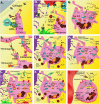Platelet Metabolism and Other Targeted Drugs; Potential Impact on Immunotherapy
- PMID: 29732316
- PMCID: PMC5919962
- DOI: 10.3389/fonc.2018.00107
Platelet Metabolism and Other Targeted Drugs; Potential Impact on Immunotherapy
Abstract
The role of platelets in cancer progression has been well recognized in the field of cancer biology. Emerging studies are elaborating further the additional roles and added extent that platelets play in promoting tumorigenesis. Platelets release factors that support tumor growth and also form heterotypic aggregates with tumor cells, which can provide an immune-evasive advantage. Their most critical role may be the inhibition of immune cell function that can negatively impact the body's ability in preventing tumor establishment and growth. This review summarizes the importance of platelets in tumor progression, therapeutic response, survival, and finally the notion of immunotherapy modulation being likely to benefit from the inclusion of platelet inhibitors.
Keywords: aspirin; cyclooxygenase; immunotherapy; non-steroidal anti-inflammatory drugs; platelet inhibitors; platelets.
Figures

Similar articles
-
Carpe low-dose aspirin: the new anti-cancer face of an old anti-platelet drug.Platelets. 2018 Dec;29(8):773-778. doi: 10.1080/09537104.2017.1416076. Epub 2017 Dec 21. Platelets. 2018. PMID: 29265902 Free PMC article. Review.
-
Aspirin-sensitive asthma: abnormal platelet response to drugs inducing asthmatic attacks. Diagnostic and physiopathological implications.Int Arch Allergy Appl Immunol. 1985;78(4):438-48. doi: 10.1159/000233927. Int Arch Allergy Appl Immunol. 1985. PMID: 3934085
-
Cancer and Thrombosis: The Platelet Perspective.Front Cell Dev Biol. 2017 Jan 5;4:147. doi: 10.3389/fcell.2016.00147. eCollection 2016. Front Cell Dev Biol. 2017. PMID: 28105409 Free PMC article. Review.
-
Platelets are versatile cells: New discoveries in hemostasis, thrombosis, immune responses, tumor metastasis and beyond.Crit Rev Clin Lab Sci. 2016 Dec;53(6):409-30. doi: 10.1080/10408363.2016.1200008. Epub 2016 Jul 22. Crit Rev Clin Lab Sci. 2016. PMID: 27282765 Review.
-
Revealing profile of cancer-educated platelets and their factors to foster immunotherapy development.Transl Oncol. 2024 Feb;40:101871. doi: 10.1016/j.tranon.2023.101871. Epub 2023 Dec 21. Transl Oncol. 2024. PMID: 38134841 Free PMC article.
Cited by
-
The Provocative Roles of Platelets in Liver Disease and Cancer.Front Oncol. 2021 Jul 21;11:643815. doi: 10.3389/fonc.2021.643815. eCollection 2021. Front Oncol. 2021. PMID: 34367949 Free PMC article. Review.
-
Longitudinal analysis of complete blood count parameters in advanced-stage lung cancer patients.Thorac Cancer. 2020 Nov;11(11):3193-3204. doi: 10.1111/1759-7714.13642. Epub 2020 Sep 17. Thorac Cancer. 2020. PMID: 32941706 Free PMC article.
-
What is the potential use of platelet-rich-plasma (PRP) in cancer treatment? A mini review.Heliyon. 2020 Mar 28;6(3):e03660. doi: 10.1016/j.heliyon.2020.e03660. eCollection 2020 Mar. Heliyon. 2020. PMID: 32258495 Free PMC article. Review.
-
Better together: circulating tumor cell clustering in metastatic cancer.Trends Cancer. 2021 Nov;7(11):1020-1032. doi: 10.1016/j.trecan.2021.07.001. Epub 2021 Sep 1. Trends Cancer. 2021. PMID: 34481763 Free PMC article. Review.
-
PD-L1 Regulates Platelet Activation and Thrombosis via Caspase-3/GSDME Pathway.Front Pharmacol. 2022 Jun 15;13:921414. doi: 10.3389/fphar.2022.921414. eCollection 2022. Front Pharmacol. 2022. PMID: 35784685 Free PMC article.
References
-
- Levitan N, Dowlati A, Remick SC, Tahsildar HI, Sivinski LD, Beyth R, et al. Rates of initial and recurrent thromboembolic disease among patients with malignancy versus those without malignancy. Risk analysis using Medicare claims data. Medicine (Baltimore) (1999) 78(5):285–91.10.1097/00005792-199909000-00001 - DOI - PubMed
Publication types
Grants and funding
LinkOut - more resources
Full Text Sources
Other Literature Sources

